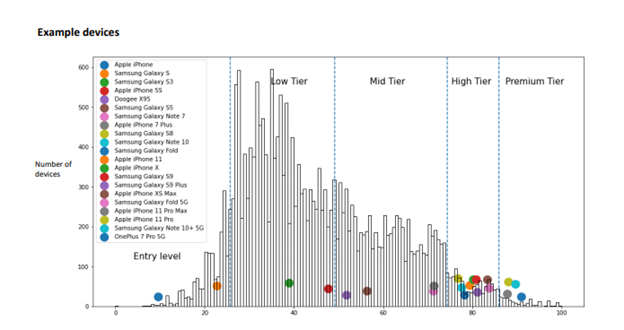
Device Hardware Classification
The number of web capable devices has grown exponentially in recent years and with each new device comes a new set of specifications, and capabilities that businesses need to be aware of.
For a company to truly deliver the best service to their customers they have to first make sure they are delivering the right content to the right people at the right time. We utilize a 5-tier model with the categories : Entry level, Low tier, Mid tier, High tier, Premium. Devices are selected in each particular category based on hardware capability broken down by a combination of standard deviation and where step changes occur in capabilities.
Today there is a widespread tightening of privacy standards worldwide which has increased the importance of non-PII data such as device type and classification. This allows for optimisation and targeting on a micro level giving a considerable competitive advantage.
Mobile Device Categories
Since the inception of cell phones in 1973, mobile device connections have surpassed the number of people in the world, making it the fastest-growing human-made technology phenomenon ever. According to GSMA real-time intelligence data, today, there are 5.27 Billion people or approx. 67% of the global population that have a mobile device.
The end user’s experience of a service is substantially governed by their device, and therefor knowledge of their device (and its capabilities) is imperative in understanding and influencing user behaviour.
High level categorization is useful, however, a more practical approach would be mobile device hardware classification. Including our new 5-tier classification system with granular device insights, DeviceAtlas gives clients an additional optimization or targeting ability. This enables many practical use cases, 3 of which are detailed below.
Three use cases of device hardware classification
Adaptive Loading - Server-Side Device Hardware Classification
This new DeviceAtlas classification property can be used to inform content adaption or Adaptive Loading. Being placed at the forefront of business practices by Google and Facebook, Adaptive Loading refers to delivering content based solely on the users device hardware capabilities (something DeviceAtlas has been promoting and championing for over 13 years now).
This concept makes the web more inclusive and accessible globally by supporting lower-end devices first and then adding features on top. As a direct result, mobile device users should have a more positive experience overall.
Additionally, there is a performance payback for businesses. According to Google research, 53% of mobile users abandon a website which takes longer than 3 seconds to load, but the average website load time on a 3G connection is 19 seconds. Mobile bounce rate has become a more important metric to view, but a lot of people tend to ignore it. A faster load on lower-end devices will reduce the number of times a website is abandoned – with an estimated average conversion rate of 3%, this could result in significant revenue for businesses.
Google’s Core Web Vitals
From June 2021, Google have indicated that the core web vitals of a website will be a direct ranking factor from an SEO perspective. These are new metrics that measure the experience a user will have on a web page.
Specifically, these are defined as the Core Web Vitals:
- Largest Contentful Paint: The time it takes for a page’s main content to load. An ideal LCP measurement is 2.5 seconds or faster.
- First Input Delay: The time it takes for a page to become interactive. An ideal measurement is less than 100 ms.
- Cumulative Layout Shift: The amount of unexpected layout shift of visual page content. An ideal measurement is less than 0.1.
Google have also placed a greater importance on the mobile friendliness of a website announcing that webpages with mobile friendly versions will rank higher than their non-optimized counterparts. As mobile device hardware classification allows for greater optimization this will greatly assist compliance with the new core web vitals and increase ranking capabilities.
Device Hardware Classification Modelling
In order to improve load times and reduce mobile bounce rate our customers regularly request a simple way of understanding the category or classification of device they are dealing with. Since device classification can be subjective, the approach taken has been to focus on the device hardware and create a model using this data. This is independent of brand and hence is more objective than measurements based on aspects such as device price. An important aspect is how the classification is maintained. This is a dynamic property, i.e. it changes over time and all devices steadily reduce as new device hardware capabilities emerge.
We also recognize that different customers or business models might need different classification than the one provided, the device score is provided as a separate property to enable customers to create their own rules if desired. The below graphs indicate how some devices are distributed, for illustrative purposes.

Device Hardware Classification Availability
Hardware Classification property is included in DeviceAtlas Enterprise licensing and allows companies to load and adapt content dynamically, so that each visitor gets an optimal viewing experience. Whether the device used is a smartphone, tablet, desktop, low-end, mid-range or high-end device, you only get one chance to make a first impression.
DeviceAtlas provides the detailed device information needed to make the right decisions. For more information and to get an enterprise trial click here




